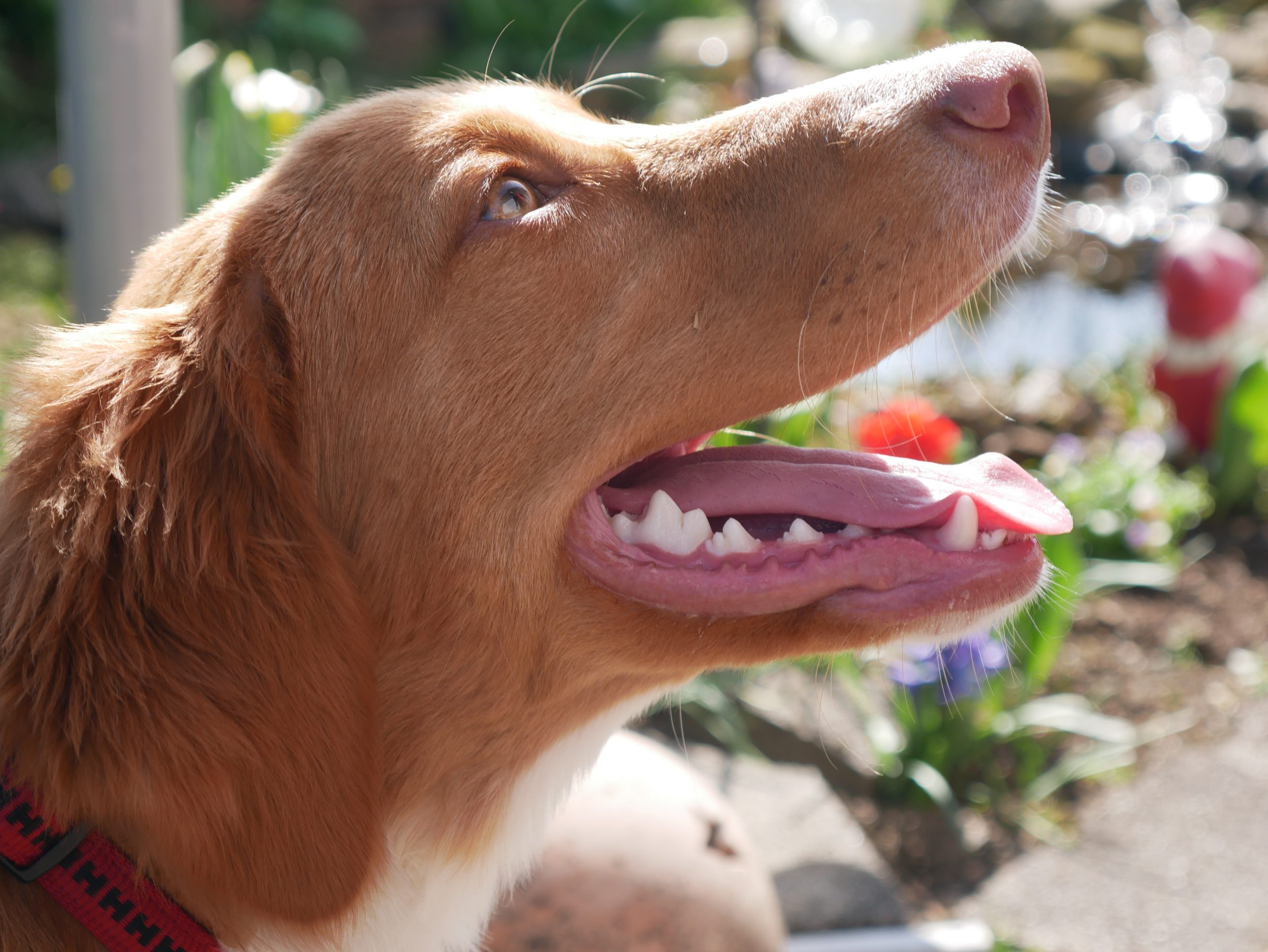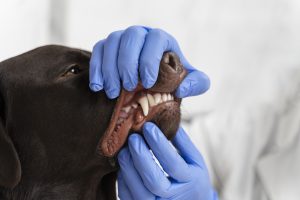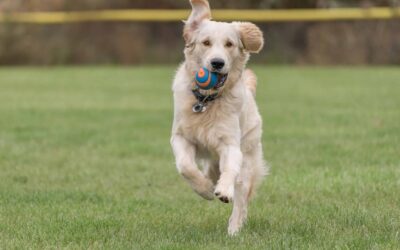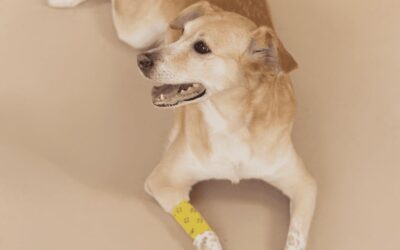Periodontal Disease Dogs: Stages, Symptoms & Treatment

What Is Periodontal Disease in Dogs?
Periodontal disease is a common dental condition that affects dogs of all breeds and ages. It is caused by a buildup of plaque and tartar on the teeth, which leads to inflammation and infection of the gums. If left untreated, periodontal disease can progress and cause serious damage to the teeth, gums, and even the underlying bone structure.
Dogs are prone to periodontal disease due to their diet, which often consists of soft and processed foods that can stick to the teeth and promote bacterial growth. Additionally, certain breeds, such as Boxers, Great Danes, Mastiffs, Bulldogs, and Collies, may be genetically predisposed to dental issues. Regular dental care and preventive measures can help reduce the risk of periodontal disease in dogs.
Stages of Periodontal Disease in Dogs
Periodontal disease in dogs can be categorized into four stages, each with its own set of symptoms and treatment options.
Stage 1: Gingivitis
At this early stage, the gums become inflamed and may appear redder than usual. There may also be some mild swelling and bad breath. Fortunately, gingivitis is reversible with proper dental care. Regular brushing, dental chews, and professional cleanings can help reverse the condition and prevent further progression.
Stage 2: Early Periodontitis
During this stage, the inflammation and infection extend below the gum line and start to affect the supporting structures of the teeth. The dog may experience pain, bleeding gums, and increased bad breath. At this point, professional dental cleaning is necessary to remove the buildup of plaque and tartar. Additional treatments, such as antibiotics or topical gels, may be prescribed to control the infection.
Stage 3: Moderate
Periodontitis In this stage, the damage to the teeth and gums is more severe. The gums may recede, exposing the roots of the teeth, and there may be significant bone loss. Dogs may show signs of discomfort while eating and may even lose teeth. Treatment options may include deep cleaning, extraction of severely affected teeth, and ongoing maintenance to manage the disease.
Stage 4: Advanced Periodontitis
At this advanced stage, the damage is extensive and irreversible. The gums recede further, leading to loose teeth and severe pain. The bone loss is severe, and the dog’s overall health may be compromised. Treatment options are limited, and extraction of all affected teeth may be necessary to alleviate pain and prevent further infection.
How Is Gingivitis Connected With Periodontal Disease?
Gingivitis is the first stage of periodontal disease and an early warning sign. It is characterized by inflammation of the gums and can be reversible with proper care. Gingivitis occurs when plaque and tartar build-up on the teeth, leading to bacterial growth and irritation of the gum tissue.
If left untreated, gingivitis can progress to more severe stages of periodontal disease. Bacteria can penetrate below the gum line, causing infection and damage to the teeth’s supporting structures. The inflammation and infection can destroy gum tissue, bone loss, and even tooth loss.
Regular dental care, including brushing your dog’s teeth, providing dental chews, and scheduling professional cleanings, can help prevent and manage gingivitis. Early detection and intervention are key to preventing the progression of gingivitis into more severe stages of periodontal disease.
Recognizing the Signs and Symptoms
Dog owners need to be aware of the signs and symptoms of periodontal disease to seek timely treatment. Some common signs to look out for include:
Bad breath (halitosis): Persistent foul odor from the mouth can indicate the presence of periodontal disease. The odor is caused by the buildup of bacteria and decaying food particles.
Bleeding gums: If you notice blood on your dog’s toys, food bowl, or while brushing their teeth, it may be a sign of gum inflammation and infection.
Swollen or red gums: Healthy gums should be pink and firm. If you observe any changes in color or texture, it could indicate the presence of periodontal disease.
Difficulty eating: Dogs with periodontal disease may experience pain while eating, leading to a reduced appetite or reluctance to chew on hard objects.
Loose or missing teeth: Advanced stages of periodontal disease can cause teeth to become loose or even fall out. This can be accompanied by increased drooling and difficulty holding food in the mouth.
If you notice any of these symptoms in your dog, it is important to consult a veterinarian who can perform a thorough dental examination and recommend appropriate treatment options.

The Impact of Untreated Periodontal Disease
Periodontal disease affects dogs’ oral health and can significantly impact their overall well-being. If left untreated, the bacteria from the infection can enter the bloodstream and spread to other organs, leading to serious complications.
Systemic Inflammation: The inflammatory response triggered by periodontal disease can affect the entire body. Chronic inflammation has been linked to various health issues, including heart disease, kidney disease, and diabetes.
Organ Damage: The bacteria can travel through the bloodstream and cause damage to vital organs, such as the heart, liver, and kidneys. This can result in organ dysfunction and even failure.
Pain and Discomfort: Dogs with untreated, periodontal disease may experience constant pain and discomfort. This can affect their quality of life, leading to behavioral changes and reduced activity levels.
Reduced Lifespan: Studies have shown a correlation between poor oral health and decreased lifespan in dogs. Regular dental care and prompt treatment of periodontal disease can help extend your dog’s life and improve their overall health.
It is essential to prioritize your dog’s dental health and seek appropriate treatment to prevent the progression of periodontal disease and its associated complications.
Preventing Periodontal Disease
Prevention is key when it comes to periodontal disease in dogs. Implementing a few simple strategies can significantly reduce the risk of your dog developing this common dental condition.
Regular Dental Care: Establishing a regular dental care routine is crucial. Brushing your dog’s teeth daily with a dog-specific toothbrush and toothpaste can help remove plaque and prevent tartar buildup. If your dog is not accustomed to brushing, start gradually and make it a positive experience by rewarding them with treats or praise.
Dental Chews and Toys: Providing your dog with dental chews and toys can help promote good oral hygiene. Chewing on appropriate items can help remove plaque and tartar buildup and stimulate the gums. Look for products that are specifically designed to promote dental health and reduce the risk of dental fracture or damage. For example, The Veterinary Oral Health Council recommends Greenies, Oravet Dental Hygiene Chews, and Purina DentaLife Daily Oral Care Dog treats, amongst others.
Professional Dental Cleanings: Regular visits to the veterinarian for professional dental cleanings are essential. These cleanings involve the removal of plaque and tartar from the teeth, as well as a thorough examination of the oral cavity. Your veterinarian may also recommend dental X-rays to assess the health of the teeth and underlying structures.
Dietary Considerations: Your dog’s diet can affect their dental health. Feeding a balanced diet that includes chewy and crunchy foods can help naturally clean the teeth and massage the gums. Avoid feeding sticky or sugary treats, as they can contribute to plaque formation.
Regular Check-ups: Routine veterinary check-ups are vital for monitoring your dog’s dental health. Your veterinarian can identify early signs of periodontal disease and guide preventive measures.
By incorporating these preventive measures into your dog’s routine, you can significantly reduce the risk of periodontal disease and ensure their long-term oral health.
Treating Periodontal Disease
The treatment of periodontal disease in dogs depends on the stage and severity of the condition. Early detection and intervention can help prevent the progression of the disease and minimize the impact on your dog’s oral health. Here are some common treatment options:
Professional Dental Cleaning: A professional dental cleaning performed by a veterinarian is typically recommended for dogs with mild to moderate periodontal disease. This procedure involves removing plaque and tartar from the teeth, both above and below the gum line. It is usually performed under general anesthesia to ensure the safety and comfort of the dog.
Extractions: In cases where the teeth are severely affected and cannot be saved, extractions may be necessary. This involves removing the affected teeth to eliminate the source of infection and alleviate pain.
Antibiotics and Pain Management: Depending on the stage and severity of the disease, antibiotics may be prescribed to control bacterial infection. Pain medications may also be prescribed to alleviate any discomfort associated with the condition.
Oral Rinse or Gel: In some cases, your veterinarian may recommend the use of an oral rinse or gel to help control bacterial growth and promote gum healing. These products are typically applied directly to the affected areas of the mouth.
Ongoing Maintenance: After the initial treatment, ongoing maintenance is crucial to prevent the recurrence of periodontal disease. This may include regular dental cleanings, at-home dental care, and dietary modifications.
It is important to work closely with your veterinarian to develop a treatment plan that is tailored to your dog’s specific needs. Regular follow-up appointments will be necessary to monitor the progress and ensure the long-term success of the treatment.
Home Care for Dogs with Periodontal Disease
In addition to professional treatment, home care plays a crucial role in managing periodontal disease in dogs. Here are some effective home care strategies to incorporate into your dog’s routine:
Regular Brushing: Brushing your dog’s teeth at home is one of the most effective ways to prevent and manage periodontal disease. Use a dog-specific toothbrush and toothpaste to brush your dog’s teeth and gums gently. Start slowly and gradually increase the duration as your dog becomes more comfortable. Be sure to reward your dog with praise or treats to make the experience positive.
Dental Wipes or Pads: Dental wipes or pads can be an alternative if your dog is not comfortable with a toothbrush. These products are designed to remove plaque and debris from the teeth and gums. Simply wrap the pad or wipe around your finger and gently rub it along the teeth and gum line.
Dental Chews and Toys: Providing your dog with dental chews and toys can help promote good oral hygiene between professional cleanings. Chewing on appropriate items can help remove plaque and tartar buildup and stimulate the gums. Look for products that are specifically designed to promote dental health.
Water Additives: Water additives can help control bacterial growth and freshen your dog’s breath. These additives are simply added to your dog’s drinking water and can provide additional support for oral health.
Dietary Modifications: Feeding a balanced diet that includes chewy and crunchy foods can help naturally clean the teeth and massage the gums. Avoid feeding sticky or sugary treats, as they can contribute to plaque formation.
Regular Check-ups: Schedule regular veterinary check-ups to monitor your dog’s oral health and ensure that any signs of periodontal disease are addressed promptly. Your veterinarian can guide home care techniques and recommend appropriate products for your dog’s specific needs.
Consistency is key for in-home care for dogs with periodontal disease. Incorporating these strategies into your dog’s routine can help manage the condition and improve their oral health.
What’s the Cost of Treating Periodontal Disease?
The cost of treating periodontal disease in dogs can vary depending on several factors, including the stage of the disease, the severity of the condition, and the geographical location. Here are some common expenses associated with treating periodontal disease:
Professional Dental Cleaning: A professional dental cleaning can range from $200 to $800, depending on the complexity of the procedure and the location. Additional costs for pre-anesthetic bloodwork, dental X-rays, and other diagnostic tests may be incurred.
Extractions: The cost of tooth extractions can vary depending on the number of teeth involved and the complexity of the procedure. A single tooth extraction can range from $10 to $400 on average.
Medications: Antibiotics and pain medications prescribed to manage periodontal disease can add to the overall cost of treatment. The cost of these medications will depend on the type, dosage, and duration of treatment.
Ongoing Maintenance: After the initial treatment, ongoing maintenance is necessary to prevent the recurrence of periodontal disease. This may include regular dental cleanings, at-home dental care products, and dietary modifications. The cost of these maintenance measures should be factored into the overall cost of treatment.
How Can Pet Insurance Help You if Your Dog Has Periodontal Disease?
Pet insurance can be a valuable tool in managing the costs of treating dog periodontal disease and other veterinary expenses. By having a pet insurance policy in place, you can have peace of mind knowing that you can provide medical care for your furry companion without worrying about the financial burden. Pet insurance can help cover the costs of veterinary consultations, diagnostic tests, medications, and even specialized treatments if required.
Reimbursement
This method is the most common for pet insurance companies. You pay out of pocket for the veterinarian bill, and then the insurance company reimburses you for what’s covered under the insurance plan. The steps look like this.
- You pay the vet bill after your dog’s visit.
- You fill out the pet insurance claim form.
- Submit the claim form and other required documentation to the insurer.
- After the claim is approved, you will be reimbursed for eligible expenses.
What Does Odie Pet Insurance Cover?
Pet insurance covers various veterinary expenses, providing financial protection and peace of mind for pet owners. Here are the details of the coverage options offered by Odie Pet Insurance:
Illness & Injury Plan
The Illness & Injury Plan is an all-inclusive insurance plan designed to cover a wide range of medical needs for your pet. This plan includes comprehensive coverage for various illnesses, injuries, and veterinary services. Some of the covered items include:
- 24/7 Televet Chat
- Emergency vet visits
- Overnight hospital stays
- IV Fluids & Medications
- Medical Supplies
- Surgeries
- MRI/CAT Scans
- Rehabilitative Care
- Prescription Medications
- Gastrointestinal issues
- Laboratory Tests
Accident-Only Plan
The Accident-Only Plan is designed for pet owners seeking coverage specifically for accidents. This plan provides financial protection for emergency veterinary care resulting from accidental injuries. It includes 90% reimbursement up to $10,000 each year, with a $250 annual deductible.
Here’s an overview of the Accident-Only Plan:
- Coverage for broken bones, sprains, eye injuries, and traumatic dental fractures.
- Coverage for wounds, including bite wounds, lacerations, snake bites, and bee stings.
- Veterinary treatments covered for accidental injuries include X-rays & ultrasounds, laboratory tests, emergency care, hospitalization, CT scan & MRI, and surgery.
The Wellness Add-on Plan
The Wellness Plan is an add-on for routine care coverage you can purchase with an insurance policy. It focuses on preventive care and covers routine veterinary services. Odie has two wellness plan options available:
Basic Plan:
- Covers services such as spay/neuter and teeth cleaning, rabies vaccination, flea & tick prevention, heartworm prevention, vaccination/titer, wellness exam, heartworm test or FELV screen, blood, fecal, parasite exam, microchip, urinalysis or ERD, and deworming.
- Reimbursement up to $305 per year.
Plus Plan:
- Ideal for puppies and kittens.
- Covers services such as spay/neuter and teeth cleaning, rabies vaccination, flea & tick prevention, heartworm prevention, vaccination/titer, wellness exam, heartworm test or FELV screen, blood, fecal, parasite exam, microchip, urinalysis or ERD, and deworming.
- Reimbursement up to $535 per year.




